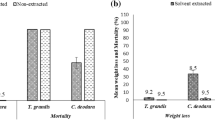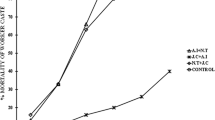Abstract
Wood extracts of four selected Malaysian timbers, Neobalanocarpus heimii, Cotylelobium lanceolatum, Madhuca utilis and Shorea curtisii, were tested at various concentrations against the subterranean termites, Coptotermes curvignathus and C. gestroi, and the fungi, Trametes versicolor (white-rot), Lentinus sajor-caju (white-rot), and Coniophera puteana (brown-rot). Paper discs were treated with 0.5, 1, and 2% w/v extracts and exposed to termites using a no-choice test. For the wood decay test, blocks of a non-durable species, Hevea brasiliensis, were treated with 2, 4, 6, and 8% of each extractive concentration and exposed to termites for a 12-week period. The results showed that 2% w/v of N. heimii extract was highly effective against both the termite species, C. curvignathus and C. gestroi after 10 days of exposure, leading to complete mortality with slight attack of the filter paper (mass loss = 1.10% and 0.69%, respectively). The 0.5% w/v extract resulted in 50% termite mortality with 2.53% and 1.42% filter paper consumption. Maximum weight losses were observed with 2% of each wood extractive against each fungus tested. Higher concentrations were needed when it comes to controlling fungi. The results from this study indicate that Malaysian wood extracts show some promise as alternative termiticides or fungicides.


Similar content being viewed by others
References
Abdul Razak MA, Low CK, Azizol AK (1982) A phytochemical screening of some Malaysian hardwoods. Malaysian Forester 45(3):398–403
Ani S, Mohd Shukari M, Mohd Dahlan J (2002) Properties and uses of commercial timbers of Peninsular Malaysia. Technical Guide No. 7. Forest Research Institute Malaysia, Kepong, Malaysia
ASTM D2017 (2005) Standard method of accelerated laboratory testing of natural decay resistance of wood. ASTM D2017. In: ASTM annual book of standards vol 4.10 wood. American Society for Testing and Materials. American Society for Testing and Materials (ASTM), West Conshohocken, pp 344–348
Blanchette RA (2000) A review of microbial deterioration found in archaeological wood from different environments. Int Biodeterior Biodegr 46:189–204
Croteau R, Kutchan TM, Lewis NG (2000) Natural products (secondary metabolites) Chap. 24. Biochemistry and molecular biology of plants. Am Soc Plant Physiol 24:1250–1318
Farkhanda M, Narjis N, Saadiya AM, Bina SS, Azka S, Sobiya P (2012) Chemical analysis and comparison of antitermitic activity of essential oils of neem (Azadirachta indica), vetiver (Vetiveria zizanioides) and mint (Mentha arvensis) against Heterotermes indicola (Wasmann) from Pakistan. Asian J Chem 24:2069–2074
Grace JK (2003) Approaches to biological control of termites. Sociobiology 41:115–120
Hillis WE (1987) Heartwood and tree exudates. Amount of extractives. Springer, Berlin
Ishida Y, Goto K, Hiroaki Y, Tsuge S, Ohtani H, Sonoda T, Ona T (2007) Direct analysis of phenolic extractives in wood by thermochemolysis-gas chromatography in the presence of tetrabutylammonium hydroxide. J Anal Appl Pyrol 78:200–206
Johnston SR, Boddy L, Weightman AJ (2016) Bacteria in decomposing wood and their interactions with wood-decay fungi. FEMS Microbiol Ecol 92(11):1–12
Khan MA, Ahmad W (2017) Termites and sustainable management: Economic losses and management. Vol. 2. Springer, Heidelberg. ISBN 978-3-319-68726-1
Kirker GT, Blodgett AB, Arango RA, Lebow PK, Clausen CA (2013) The role of extractives in naturally durable wood species. Int Biodeterior Biodegr 82:53–58
Kusuma IW, Tachibana S (2007) Antifungal compounds isolated from tropical and temperate wood. In: Argyropoulos DS. (ed.) Material, chemicals and energy from forest biomass. American Chemical Society, Washington D.C., pp 377–390
Majid AHA, Ahmad AH, Gurbel SS (2013) Laboratory evaluation of transfer effect of termiticides as a slow-acting treatment against subterranean termite Coptotemes gestroi (Isotera: Rhinotermitidae). Int J Entomol Res 01(01):32–41
Messer A, McCormick K, Sunjaya Hagedorn HH, Tumbel F, Meinwald J (1990) Defensive role of tropical tree resins: antitermitic sesquiterpenes from Southeast Asian Dipterocarpaceae. J Chem Ecol 16:3333–3352
Ohkuma M (2003) Termite symbiotic systems: efficient bio-recycling of lignocellulose. Appl Microbiol Biotechnol 61:1–9
Onuorah E (2000) The wood preservative potential of heartwood extracts of Milicia excelsa and Erythrophleum suaveolens. Bioresour Technol 75(2):171–173
Rodrigues AMS, Stien D, Eparvier DV, Espindola LS, Beauchene J, Amusant N, Lemenager N, Baudasse C, Raguina L (2012) The wood preservative potential of long-lasting Amazonian wood extracts. Int Biodeterior Biodegr 75:146–149
Roszaini K (2011) Wood extractives as natural preservatives against termite and fungi. PhD Thesis. Bangor University, United Kingdom. 406 pp
Roszaini K, Hale MD (2017) Antioxidant potential and content of phenolic compounds in extracts of twelve selected Malaysian commercial wood species. Eur J Wood Prod 75:615–622
Roszaini K, Nor Azah MA, Mailina J, Zaini S, Mohammad Faridz Z (2013) Toxicity and antitermite activity of the essential oils from Cinnamomum camphora, Cymbopogon nardus, Melaleuca cajuputi and Dipterocarpus sp. against Coptotermes curvignathus. Wood Sci Technol 47(6):1273–1284
Roszaini K, Nor Azah MA, Zaini S, Zaitihaiza K (2014) Anti-termitic potential of heartwood and bark extract and chemical compounds isolated from Madhuca utilis Ridl. H. J. Lam and Neobalanocarpus heimii King P. S. Ashton Holzforschung 68(6):713–720
Roszaini K, Hale MD, Salmiah U (2016) In-vitro decay resistance of 12 Malaysian broadleaf hardwood trees as a function of wood density and extractives compounds. J Trop For Sci 28(4):533–540
Sakai K (2001) Chemistry of bark. In: Hon DNS, Shiraishi N (eds.) Wood and cellulosic chemistry, 2nd edn. Marcel Decker, New York
Salem MXM, Zidan YE, Hadidi EL, Mansour NMN, Abo Elgat MMA (2016) Evaluation of usage three natural extracts applied to three commercial wood species against five common molds. Int Biodeterior Biodegr 110:206–226
Silva CA, Monteiro MBB, Brozolin S, Lopez ACG, Richter A, Braga MR (2007) Biodeterioration of brazilwood Caesalpinia echinata Lam. (Leguminosae – Caesalpinioideae) by rot fungi and termites. Int Biodeterior Biodegr 60:285–292
Taylor AM, Gartner BL, Morrell JJ (2002) Heartwood formation and natural durability—a review. Wood Fib Sci 34:587–611
Vek V, Oven P, Humar M (2013) Phenolic extractives of wound-associated wood of beech and their fungicidal effect. Int Biodeterior Biodegr 77:91–97
Verma M, Sharma S, Prasad R (2009) Biological alternatives for termite control: a review. Int Biodeterior Biodegr 63:959–972
Watanabe Y, Mihara R, Mitsunaga T, Yoshimura T (2005) Termite repellent sesquiterpenoids from Callitris glaucophylla heartwood. Forest Ecol Manag 258:1918–1923
Weber JFF, Wahab IA, Marzuki A, Thomas NF, Kadir AA, Hadi AHA, Awang K, Abdul Latiff A, Richomme P, Delaunay J (2001) Heimiol A, a new dimeric stilbenoid from Neobalanocarpus heimii. Tetrahedron Lett 42(29):4895–4897. https://doi.org/10.1016/S0040-4039(01)00772-9
Yang G, Jaakkola P (2011) Wood chemistry and isolation of extractives from wood. Literature study for BIOTULI project. Saimaa University of Applied Sciences, South Karelia
Zhang X, Nguyen D, Paice M, Tsang Renaud S (2007) Degradation of wood extractives on thermo-mechanical pulp by soybean lipoxygenase. Enzyme Microb Technol 40:866–873
Acknowledgements
The authors are very grateful to acknowledge the support of the Ministry of Natural Resources and Environmental, Malaysia for providing the scholarships for this study. This paper is part of the first author’s PhD thesis. The authors also thank the staff of Wood Entomology Laboratory, Forest Research Institute of Malaysia (FRIM), Malaysia and Wood Science Laboratory, Bangor University, United Kingdom for their invaluable technical support and assistance in the laboratory studies.
Author information
Authors and Affiliations
Corresponding author
Ethics declarations
Conflict of interest
The authors have declared that they have no conflict of interest.
Additional information
Publisher’s Note
Springer Nature remains neutral with regard to jurisdictional claims in published maps and institutional affiliations.
Rights and permissions
About this article
Cite this article
Kadir, R., Hale, M. Biocidal potential of the extractives of four Malaysian timbers against subterranean termites and wood decay fungi. Eur. J. Wood Prod. 77, 147–155 (2019). https://doi.org/10.1007/s00107-018-1361-5
Received:
Published:
Issue Date:
DOI: https://doi.org/10.1007/s00107-018-1361-5




